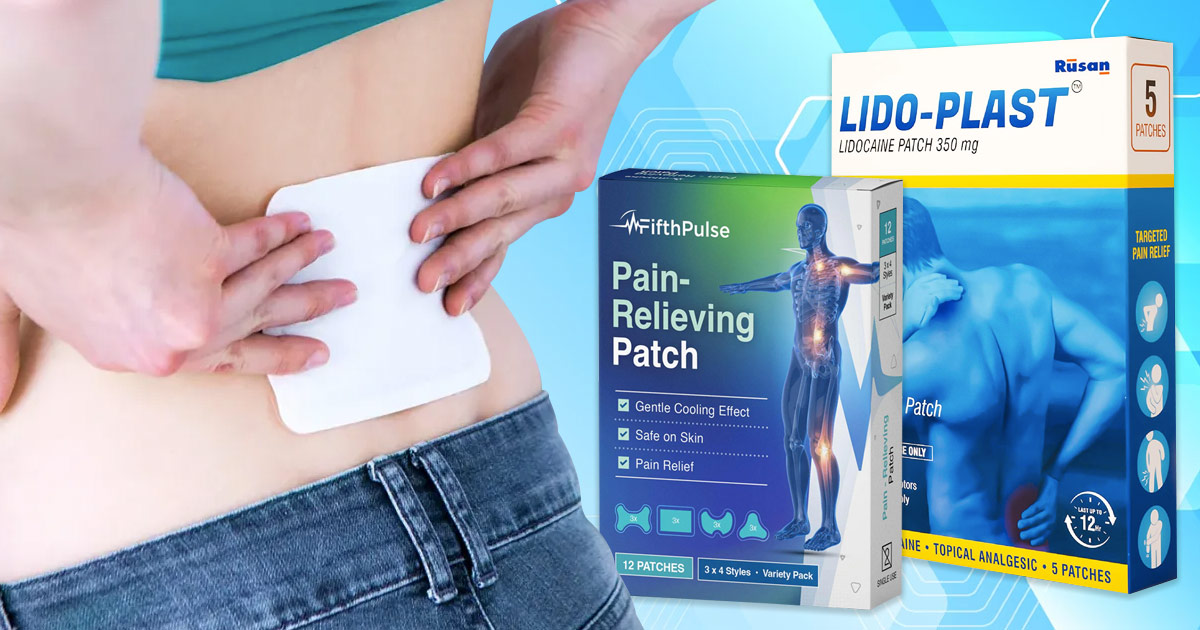Top Pain Relief Patches: Types, Ingredients, and How They Work

Managing pain, whether it’s from chronic conditions, injuries, or muscle overuse, can be challenging. Pain relief patches offer a targeted, convenient way to ease discomfort. They work by delivering medication directly to the skin, offering localized relief without the side effects of oral medication. With a variety of options available, including capsaicin, lidocaine, menthol-based, NSAID-based, and fentanyl patches, there’s a solution for nearly every kind of pain.
With millions of people worldwide managing conditions like arthritis, muscle soreness, and nerve pain, pain relief patches are becoming increasingly popular. But how do they work, and which one is best for your needs?
How Do Pain Relief Patches Work?
Pain relief patches work by delivering active ingredients through the skin to the affected area. Depending on the type of patch, they can either numb irritated nerves, reduce inflammation, or create hot and cold sensations to distract your brain from the pain. Here’s how different patches work:
- Lidocaine patches block pain signals by numbing the nerves in the application area.
- Capsaicin patches reduce pain by desensitizing nerve endings over time.
- Menthol-based patches like Biofreeze or Icy Hot mimic cold and heat therapy to soothe sore muscles and joints.
- NSAID-based patches, such as diclofenac, fight inflammation in deeper tissues.
- Fentanyl patches deliver strong opioid medication for severe, long-term pain like cancer-related discomfort.
Choosing the Best Pain Relief Patch for You
With so many options available, it’s important to understand the benefits and best uses of each type of patch.
1. Lidocaine Patches for Nerve Pain
Lidocaine patches are often recommended for nerve-related pain, such as postherpetic neuralgia (pain from shingles) or diabetic neuropathy. These patches numb the area by blocking pain signals from nerves and are available over-the-counter in 4% strength. Prescription patches, like Lidoderm (5% lidocaine), are stronger and are ideal for more severe nerve pain.
If you’re looking for quick relief from sharp, burning sensations, lidocaine patches are among the best options available. They’re also excellent for temporary pain relief in areas like the lower back or shoulders.
2. Capsaicin Patches for Persistent Pain
Capsaicin patches, made from the active ingredient in chili peppers, work by desensitizing pain pathways in the nerves. They’re well-suited for conditions like arthritis, diabetic neuropathy, or even localized chronic pain. OTC versions, such as Salonpas HOT or Aspercreme Warming, are great for minor pain. High-strength patches like Qutenza (8% capsaicin) are available by prescription for targeted neuropathic pain relief.
Be prepared for an initial warming or burning sensation upon application, which usually fades with repeated use. Capsaicin patches are particularly effective for long-term pain management.
3. Menthol-Based Patches for Muscle Pain
Products like Biofreeze and Icy Hot patches use menthol to provide a cooling effect that eases soreness and stiffness. Many of these patches also incorporate heat therapy, creating warming sensations that promote blood flow and relax tight muscles.
Biofreeze is a great choice for athletes dealing with muscle fatigue, while Icy Hot patches are often considered the best for lower back pain or neck pain from overuse. These patches don’t numb the area but instead distract the brain with hot and cold sensations, mimicking ice and heat packs.
4. NSAID-Based Patches for Joint Pain and Chronic Conditions
NSAID patches, such as those containing diclofenac, like the Flector patch, deliver anti-inflammatory medication directly to the affected joint or muscle. They are particularly useful for arthritis pain, tendonitis, or serious joint inflammation. These patches combine relief from swelling and stiffness, making them an excellent choice for knee pain or chronic joint discomfort.
Studies have shown that NSAID patches are as effective as oral medication but without the gastrointestinal side effects, making them a safer option for many.
5. Fentanyl Patches for Severe Chronic Pain
For individuals with severe, long-term pain, such as cancer-related discomfort, fentanyl patches are often prescribed. These patches slowly release a powerful opioid over 72 hours, providing consistent, round-the-clock pain relief. Fentanyl is only suitable for patients who are already opioid-tolerant and require advanced pain management.
These patches come with significant risks, including the potential for overdose, so they must be used under strict medical supervision. Fentanyl patches should never be combined with heat, as this can increase the absorption rate and lead to dangerous side effects.
Do Pain Relief Patches Really Work?
Yes, pain relief patches are highly effective when used properly. Millions of people rely on them for managing various types of pain. For example, studies have shown that lidocaine and NSAID patches significantly reduce both nerve and joint pain, while menthol and capsaicin patches are excellent for soothing muscle and arthritis discomfort.
However, not all patches are interchangeable. It’s important to match the patch type with your specific pain to get the best results. Always consult a doctor or pharmacist if you’re unsure which patch is right for you.
Tips for Safe and Effective Use
1. Apply to Clean Skin
Make sure your skin is clean and dry before use. Avoid broken or irritated skin.
2. Follow Instructions
Adhere to usage limits (e.g., 8-12 hours for most patches). Don’t apply heat unless advised.
3. Store Safely
Keep patches away from children and pets, especially prescription-strength patches.
4. Dispose Properly
Fold used patches so the adhesive sticks together and discard them securely.
Take Back Control with the Right Pain Relief Patch
Pain relief patches offer a convenient and effective solution for managing discomfort. Whether you’re dealing with nerve pain, sore muscles, or arthritis, there’s a patch tailored to your needs. From lidocaine for nerve pain to menthol patches for back and neck pain and even prescription options like fentanyl or NSAID strips, finding the right patch can help you regain control over your life.
If OTC patches don’t work or your pain worsens, consult your doctor for guidance. With the right patch and proper use, you can find reliable relief and get back to doing the things you enjoy.
